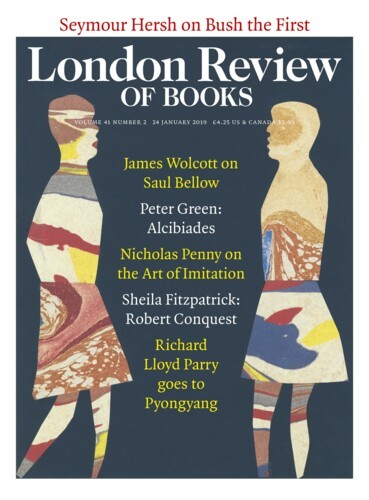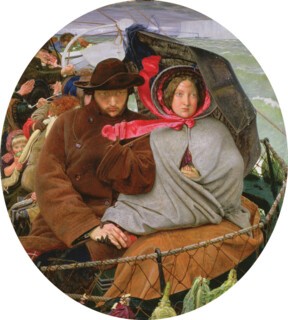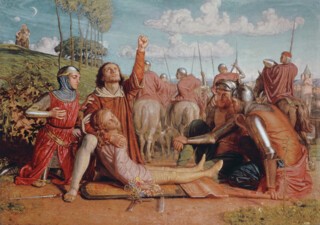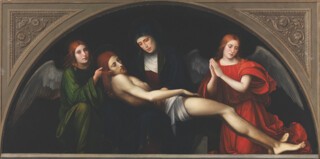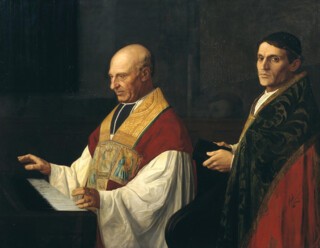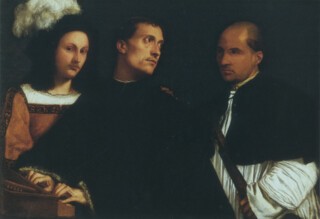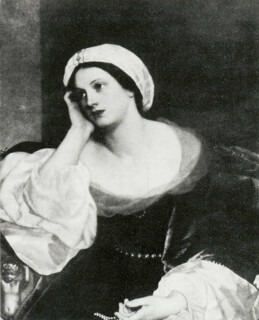Elizabeth Prettejohn’s book opens with a discussion of The Last of England by Ford Madox Brown, made in 1852-55 and now in Birmingham Museum and Art Gallery. The painting shows a couple leaving England for Australia on a crowded boat. It is insistent in its sharp focus, and brilliant, even strident, in its modern palette: the purple and green of cabbages hanging from the ship’s railing, the bright rose of a windswept silk bonnet ribbon cutting across the centre of the picture, and the mauve fingers of an otherwise concealed infant. The taut composition is compressed into an almost circular frame. The setting on a boat rocked by a rough sea provides one explanation for the absence of any reliable horizontal and for the choice of this inherently unstable format.
It has long been almost obligatory to suggest that Brown was inspired by the tondo paintings of late 15th-century Florence, especially those by Botticelli. But Prettejohn cautions against ‘the recidivist habit of the art historian’. The format was also familiar from engravings and copies of Raphael’s paintings (especially the Madonna della Sedia) and had been adopted in famous paintings by Thomas Lawrence and Ingres. Moreover, the style of Brown’s painting owes nothing to Botticelli. It does, however, owe something to the example of Van Eyck’s Arnolfini portrait, with its central convex mirror, which had been acquired by the National Gallery in 1842. Many art historians have emphasised the ways in which the Pre-Raphaelites imitated the art of the past. Prettejohn not only looks again at the nature of this imitation but demonstrates how it enabled them to contribute to the re-evaulation of that art.
The paradox of the Pre-Raphaelites is that they turned for inspiration to Dante and to the daguerreotype – to influences more ancient and more modern than anything afforded by the orthodox artistic training of their time. Modern technology also suggested new shapes. Photographs, when framed or mounted, usually had curved corners, or an arched top, or were oval, or (less commonly) circular. There was a technical reason for this: the need to conceal fading caused by the ‘fall off’ at the edges of a lens in the process of both making and printing a photograph. Prettejohn considers the significance for Millais of the ‘old-fashioned arched format’ he chose for his portrait of Ruskin (now in the Ashmolean) although ‘everything else in the scene seems to be about modern scientific investigation’, but her argument would need to be modified if photography were taken into account.
In the case of The Last of England, not only the lens of the camera but of the telescope is pertinent. This genteel, educated couple with their baby and bundle of books, packed uncomfortably close to rough company on a long, hard journey, are out of range of normal sight and unaware that we can still share their worries and apprehension. England, disappearing behind them, has shrunk to distant white cliffs; they have ceased to look at it. The couple are viewed as though down a telescope. This adds poignancy and even urgency to the beholder’s situation. (Oddly, no one seems to have considered the influence that the telescope may have had, at some level, in the making and reception of the painting, even though telescopes had recently become popular at the seaside.)
Art historians are now more than ever interested in quotation or citation, and ‘to reference’ has become a favourite verb on museum labels, often without any explanation of the significance or likelihood of the connection. Prettejohn has thoroughly investigated the paintings that were available to the artists she discusses. She is not merely acute in her detection of similarities, but takes account of the opportunities and priorities prevailing when the artist being discussed was at work. When she observes of Holman Hunt’s early painting Rienzi Vowing to Obtain Justice for the Death of His Young Brother (1849) that the dead boy stretched across the foreground resembles Christ in Francesco Francia’s Pietà, whose limbs ‘looked too thin and too long to those trained in normative anatomy’, she does so in the knowledge that the acquisition of Francia’s painting for the National Gallery in 1841 was the first major attempt by the trustees to broaden the canon of art that was represented by the national collection. She has even discovered a little-known text in which an academician deplores the arrival of the painting at the very moment Hunt must have been studying it, describing it as a concession to the taste of the ‘bigoted devotees to the earlier masters’. Francia’s painting certainly seems to be a source for Hunt’s, especially if we consider that it was then displayed not as a lunette above his rectangular altarpiece, as originally intended (and as we see it today), but separately, so that it was easier to admire and to copy. Whether we should consider this as a reference – whether it is an imitation made to be recognised as such, and if so, by whom – is a different matter.
In her final chapter Prettejohn places Rehearsing the Service, which Alphonse Legros exhibited at the Royal Academy in 1870 (now in the Tate Gallery’s collection, but not on display), next to The Concert by Titian (perhaps with another artist), then generally considered to be by Giorgione. Both paintings show figures at a keyboard, which is placed at the bottom left corner of the canvas. The connection, once made, seems obvious, although we may wonder whether many people recognised it at the time. Prettejohn comes to it by way of Walter Pater’s essay on Giorgione of the same period, in which Legros is mentioned. Pater has never had a more careful and sympathetic reader or one better able to demonstrate how subtle and radical his ideas of influence and cultural inheritance were. Noting the way in which he alludes to A Man in Armour in the National Gallery, then often still attributed to Giorgione, she refers to its possible influence on George Frederic Watts in the 1860s and Edward Burne-Jones in the 1870s. It also influenced Pater’s own fiction, as readers of Marius the Epicurean (1885) will appreciate: the young knight Cornelius tries on his armour ‘and as he gleamed there amid that old interchange of light and shade, with the staff of a silken standard firm in his hand, Marius felt as if he were face to face, for the first time, with some new knighthood or chivalry, just then coming into the world.’ If Pater does not mention Giorgione directly here, it is not because of the anachronism but to reserve the reference for a sympathetic minority, an inner circle. Did Legros, for similar reasons, refrain from adding to his painting’s title the words ‘After Giorgione’?
Artists could provide clues by inscribing a text on the painting or on the frame, or by some brief addition to its title in an exhibition catalogue. It is doubtful whether many of the visitors, or even the critics, followed the hint in the Royal Academy’s catalogue of 1851 that No. 135, Charles Eastlake’s Ippolita Torelli, was an imaginary portrait of the wife of Baldassare Castiglione looking at Raphael’s famous portrait of her husband. Eastlake’s painting wasn’t a mere costume piece in the Renaissance style; it was claiming to be a pendant to one of the greatest of European portraits. (Unfortunately the painting, bequeathed by Lady Eastlake to the National Gallery, was destroyed in the flood of 1928 at the Tate Gallery, to which it had been transferred.) It illustrates the taste – not just for Raphael but for Guido Reni – against which the Pre-Raphaelites rebelled, but it also reveals that their interest in recondite poetic allusions and imitation was anticipated by artists such as Eastlake, who became president of the Royal Academy in 1850. The painting is also informed by the fascination with the Venetian cinquecento that, nearly a decade later, Rossetti would display in his imaginary portraits – although these were often of less respectable ladies.
Prettejohn writes especially well about the way the idea of the Renaissance was gradually formed during the period ‘from the Pre-Raphaelites to the First World War’, by the work of artists, as well as by collectors, curators, critics and poets. Eastlake’s Ippolita Torelli is one illustration of this process. The many examples of Mantegnesque classicism are another. Prettejohn repeatedly evokes the ways in which the expanding National Gallery influenced artists and was influenced by them. Such interchanges owed something to the fact that for several decades the Royal Academy and its schools occupied the same building as the National Gallery, still more to the fact that the directors of the National Gallery were (or had been) artists as well as scholars. Even more important, perhaps, was the relatively small cultural world in London.
Nowhere is the nature of influence and the degree of imitation harder to assess with precision than in the art of Burne-Jones. Prettejohn proposes that the five angels with ‘bare feet and solid stance’ in his watercolour series The Days of Creation, exhibited in 1877, bring to mind the angels in Piero della Francesca’s Nativity (1470-75), bought for the National Gallery a few years before. Her claim that Burne-Jones’s watercolour ‘immediately recalls’ Piero’s painting not only exaggerates the obviousness of the connection but underestimates her own originality, since no one has previously made this suggestion. Burne-Jones was so familiar with the art of the quattrocento that he may not have been conscious of a debt of this kind. The mouths of two of Piero’s angels are open in song. The lips of those in Burne-Jones’s painting are sealed. For Prettejohn a deeper connection may be concealed by these differences. ‘Perhaps,’ she writes, the spheres held by Burne-Jones’s figures ‘retain some hint of the Nativity’s musical instruments’ and thus evoke the music of the spheres. This is the only point in the book that is over ingenious.
Prettejohn’s most daring proposal is that Van Eyck, Giorgione, Botticelli, Piero and Velázquez only really became ‘masters’ when they were adopted by 19th-century artists who wished to present themselves as their pupils. This is surely true of Botticelli (about whose rediscovery Prettejohn writes with exceptional shrewdness) and Giorgione (although there is a longer history of fascination with this artist). The case of Velázquez is different because, although he only came to be widely considered as central to any canon of European art in the second half of the 19th century, there was high esteem for his work in the 18th century, and some of his paintings, most obviously his portrait of Pope Innocent X, had never ceased to be regarded as masterpieces.
Even as we qualify our assent, Prettejohn presents another challenge to conventional thinking, this time concerning originality. She wants to show that ‘artists may be most themselves – most significant aesthetically as well as historically – when they draw closest to the precursors they wish to explore.’ She admits to having been impressed by Harold Bloom’s model of the modern poet’s patricidal struggle, ‘wrestling with strong precursors even to the death’, which may be an apt description of some of Turner’s imitations of the Old Masters (especially Claude) and perhaps those of Manet and Picasso. The ‘generous imitation’ she favours is less traumatic and macho, and has something in common with the approach of architectural historians, who have long since ceased to regard Gothic and Renaissance revival buildings as crass pastiches or defiant mistranslations. For Prettejohn, the artist who practises ‘generous imitation’ promotes as well as possesses a profound understanding of another artist.
She is right to see the burden of influence as a 19th-century topic, and tellingly quotes Frederic Leighton’s presidential address to the Royal Academy in 1879 in which he considered the choices facing ‘the fortunate but bewildered heir to a boundless inheritance of artistic treasure’. But artists had long been aware of this problem. Sebastiano Ricci was even reported to have told his patron, the Duke of Portland, that his friend Nicola Cassano had made forgeries for this very reason. Another Venetian painter working in the first half of the 18th century, Antonio Guardi, was employed by one of the greatest collectors in Europe, Johann Matthias von der Schulenburg, to make copies of masterpieces, and the majority of his other surviving paintings are derived from well-known works by other artists, in most cases familiar from prints. This blatant lack of originality of one kind was compatible with, and even enhanced awareness of, Guardi’s extraordinary originality in the handling of paint and in the pyrotechnic effects of light and colour. His copies or imitations can be thought of in the same way as new operas that recycled librettos, or as equivalent to musical compositions that were ‘variations’ on a familiar theme.
No great European artist better illustrates Prettejohn’s claim that artists may become most themselves when they draw closest to a precursor than Guardi’s brother-in-law, Giambattista Tiepolo. It was only after he had adopted the dressing-up box, the stage sets, the subjects, as well as many of the compositional devices and something of the palette favoured two hundred years earlier by Paolo Veronese, that he gained the confidence to become Tiepolo and to deploy, often at breathtaking altitudes and with enchanting wit, his refined and haughty princesses with their attendant pages and sages. Perhaps in such cases distance reduces the inhibitions that are attached to that imitation and endows what had seemed old-fashioned with the charm of novelty or the power of archaism. Prettejohn, although confining her examples of revivalism and rediscovery to a period in which the ‘anxiety of influence’ was dramatically increased by the expansion and foundation of public museums and galleries, and of course by easier travel, provides us with approaches which can help us to understand previous periods.
Imitation, as she interprets it, may include much more than artistic style: frames and shapes and motifs, exotic props and gold backgrounds. The next chapter in the story is of course the rejection by artists of almost everything in the art museum, and the adoption of models to be found in ethnographic collections, and in particular art deemed to be savage or barbarian – an imperialist assumption which, but for the badge of modernism, might excite disapproval today. Modernism, as Prettejohn notes in passing, also defines itself by a knowing or satirical reference to the Old Masters – the moustache on the Mona Lisa and Andy Warhol’s adaptation of a child’s version of Leonardo’s Last Supper are instances of glib blasphemy now themselves widely imitated.
Send Letters To:
The Editor
London Review of Books,
28 Little Russell Street
London, WC1A 2HN
letters@lrb.co.uk
Please include name, address, and a telephone number.
